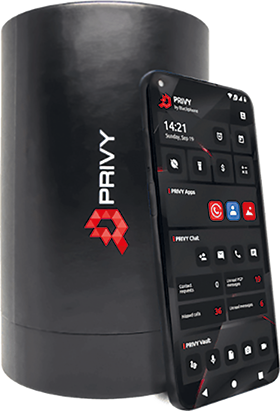

Privacy relates to any rights you have to control your personal information and how it is used. Security, by contrast, refers to how your personal information is protected. Different data about you resides in multiple places for virtually everyone who is regularly online, challenging your privacy, as well as security. Some people consider privacy and security as pretty much the same thing, but, while similar, they are different, and your mobile communications should have both.
In a world replete with endless cyberattacks, IoT devices have minimal security and it is worthwhile to bear in mind that technology today can amplify the consequences of a successful data breach more than ever. With organisations and individuals alike turning in ever increasing numbers to technology for their communications and transactions, privacy and data security is becoming a necessity, especially now that corporate data exists everywhere and goes everywhere. It lives in the cloud, it travels with us on our smartphone and tablet, it’s shared on countless social media sites and who knows where else.
Worse, a great deal of the data that people and companies deal with daily – sensitive and otherwise – is transmitted over unencrypted channels, much of it “in the open” over wireless networks where the data is easily available to bad actors looking to intercept it.
For this reason,mobile communications must be secured at all costs.
Mobile is the new front line for cyberattacks
The Blackphone PRIVY 2.0 is the smartest defence for encrypted businesses and personal communications. Blackphone is designed to quell the data scraping and web tracking that’s become such an integral part of the digital economy and mobile communications. Built to foil and protect privacy from all surface attacks and brute force, the new generation Blackphone Privy 2.0 is the world’s smartest and most secure defence for encrypted businesses and personal communications.
The Blackphone PRIVY 2.0 has been developed to address every aspect of smartphone security from the technology used to make the handset, through to the OS that runs it and the apps that can be used on it. Even how and where your data is securely held has been covered.
Features of the Blackphone
Military grade end-to-end encryption: Robust and powerful data encryption is a vital component for any security protocol used on the latest smartphones. With the next generation of Blackphone PRIVY 2.0, your communications are fully protected by a wide range of the very latest cryptographic protocols that deliver absolute data security. All your incoming and outgoing communications are secured by end-to-end encryption and only transmitted using an encrypted network. The data created is stored only on the device itself, ensuring it is fully secured and encrypted.
PRIVY Chat and PRIVY Vault: Messaging apps and unencrypted calls pose a risk to your digital communications. The Blackphone PRIVY 2.0 is delivered with preloaded applications that provide secure communications and file storage. These are PRIVY Chat and PRIVY Vault. The applications protect your data while it is in transit, with military grade end-to-end encryption, and securely store the data-at-rest in encrypted databases.
PRIVY Chat and PRIVY Vault include:
• Peer-to-peer chat.
• Secure group-chat.
• Peer-to-peer VoIP calls.
• PGP chat.
• Fully encrypted file storage
• Zero server trace storage.
Much has been written about the significant risks that are posed by tech giants storing your data and files on their own servers. They are often the target of hackers looking to exploit their infrastructure weaknesses to gain access to your information.
To address this issue head on, the Blackphone PRIVY 2.0 does not store any sensitive information from your communications. Each message created in peer-to-peer chats does not reach the locations of Blackphone’s servers. The messages created in the group chats only use Blackphone’s infrastructure to distribute the shared information. These messages are not stored for more than a week, after which they are deleted, leaving no trace.
The VoIP calls only use Blackphone’s servers to establish a connection between the peers. These privacy-focused methods have been specially developed to assure your absolute privacy.
Secure OS: The threat posed by hackers and how they operate is forever changing and evolving. Their attack methods are now using multiple endpoints and backdoors, rather than simply employing a single attack vector.
The standard consumer-grade operating systems (OS), such as Android and iOS, pay a great deal of attention to developing the user experience and functionalities, all of which comes at the expense of comprehensive security. This approach to functionality over security means that their offerings are more easily exploited by hackers. Their technical expertise and know-how mean your data is accessible to any third party that desires it.
The Blackphone PRIVY 2.0 is powered by Secure OS, which is a specially adapted operating system based on Android to focus heavily on the security factors. It deploys multiple defence layers to isolate, encrypt, and secure your data against any mobile threat.
The Secure OS deploys:
• Zero attack surface.
• Military grade encryption.
• Triple password protection.
• Verified boot.
• Trusted updates.
• Silent Phone by Silent Circle.
Silent Phone is an end-to-end encrypted application which allows users to make calls, send instant messages, and share files with other users that have the application on their device. This allows the Blackphone PRIVY 2.0 to communicate with any iOS or Android device, providing significantly wider reach and compatibility with any other secure phone.
Blackphone PRIVY 2.0 is delivered with a multi-IMSI SIM card that provides unlimited data coverage worldwide. It also includes the built-In SS7 Firewall and VPN. The SS7 Firewall helps prevent hackers from gaining access to your telephone signal as it transfers from one network to another. The VPN means that your communications are transmitted via an encrypted tunnel between you and your contact.
With these added features, it means you will be able to securely and privately communicate across the world.

© Technews Publishing (Pty) Ltd. | All Rights Reserved.